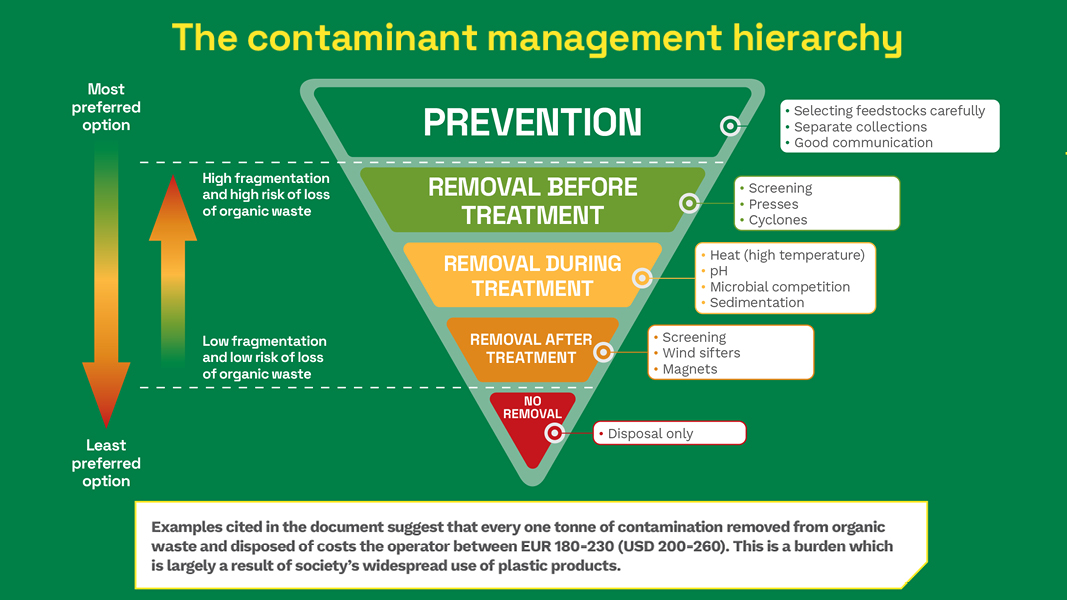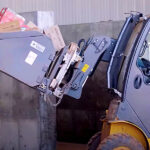Top: Graphics courtesy of International Solid Waste Association
The International Solid Waste Association’s (ISWA) new report, “A Practitioner’s Guide to Preventing and Managing Contaminants in Organic Waste Recycling,” is very timely and much needed. The report is authored by Jane Gilbert, principal of Carbon Clarity (in the United Kingdom) and Chair of the ISWA Working Group on the Biological Treatment of Waste, and Marco Ricci-Jürgensen with CIC-Italian Composting and Biogas Association and Vice-Chair of the Working Group. Along with their contributors, they review the types of contaminants, assess the impacts of collection and preprocessing options, and offer best practices for contaminant removal. The Practitioner’s Guide defines contaminants as “an undesirable item, chemical substance, or biological material in organic waste and/or its recycled product that has the potential to adversely affect the recycling process and/or the recycled end product(s) (i.e., compost or anaerobic digestate).”
A contaminant management hierarchy is presented (see feature image above), with prevention on the top, followed by removal before treatment, removal during treatment, removal after treatment, and no removal. Note the authors, “Examples cited in the document suggest that every metric ton of contamination removed from organic waste and disposed costs the operator between EUR 180-230 (USD 200-260). This is a burden which is largely a result of society’s widespread use of plastic products.” Among the primary challenges associated with contaminant removal processes — which “are largely effective but never 100% efficient” — are the “sticky” properties of water, common in organic wastes. “Water helps organic materials adhere to physical contaminants, with plastic films being particularly problematic,” write Gilbert and Ricci-Jürgensen. “Removing plastic contaminants at the start of the recycling process can result in a significant loss of organic waste (the so-called ‘dragging effect’) as well as fragmentation of the plastic, resulting in smaller pieces that subsequently become harder to remove. On the other hand, leaving plastic in the process can cause operational difficulties, concerns by regulators and disintegration of the plastic due to exposure to high temperatures, leading to further fragmentation. An imperfect balance thus needs to be found by operators.”
 ISWA’s Working Group on the Biological Treatment of Waste calls for further research and development to improve the methods and efficiencies of removing unwanted contaminants from organic waste, compost and anaerobic digestate, starting with equipment designed specifically for the organics recycling sector. “There is urgent need for improved equipment and the development of new techniques … that [take] into account the high moisture levels of waste inputs,” recommends the ISWA Working Group. “Improvements and innovation are thus essential, not only to improve operational efficiencies, but also to prevent contaminants accumulating in soil. The anticipated global uplift in organic waste recycling needed to reduce fugitive methane emissions from dumpsites, coupled with the use of compost and digestate to ameliorate arable soils and recycle plant nutrients, highlights the urgency of the task at hand.”
ISWA’s Working Group on the Biological Treatment of Waste calls for further research and development to improve the methods and efficiencies of removing unwanted contaminants from organic waste, compost and anaerobic digestate, starting with equipment designed specifically for the organics recycling sector. “There is urgent need for improved equipment and the development of new techniques … that [take] into account the high moisture levels of waste inputs,” recommends the ISWA Working Group. “Improvements and innovation are thus essential, not only to improve operational efficiencies, but also to prevent contaminants accumulating in soil. The anticipated global uplift in organic waste recycling needed to reduce fugitive methane emissions from dumpsites, coupled with the use of compost and digestate to ameliorate arable soils and recycle plant nutrients, highlights the urgency of the task at hand.”
Specific actions requested by ISWA include:
- Manufacturers selling equipment to the organics recycling industry to invest in research and development to improve contaminant removal techniques, while minimizing the concomitant loss of organic matter (the “dragging effect”).
- Managers of composting and anaerobic digestion plants to maximize the quality of their final products. Facilities should, where possible, ensure that contracts with waste producers include a clause setting a maximum contamination level. They should also specify a variable gate fee depending upon the level of contamination in the load received at the facility.
- Municipal solid waste collection companies and waste haulers to prioritize collection schemes for organic waste that enable the identification of contaminated loads and to feed this back to individual waste producers.
- Local decision makers and city managers to invest in regular information campaigns aimed at raising citizens’ awareness of the importance of maximizing the quality of organic waste for recycling.
Download “A Practitioner’s Guide to Preventing and Managing Contaminants in Organic Waste Recycling” at this link.













